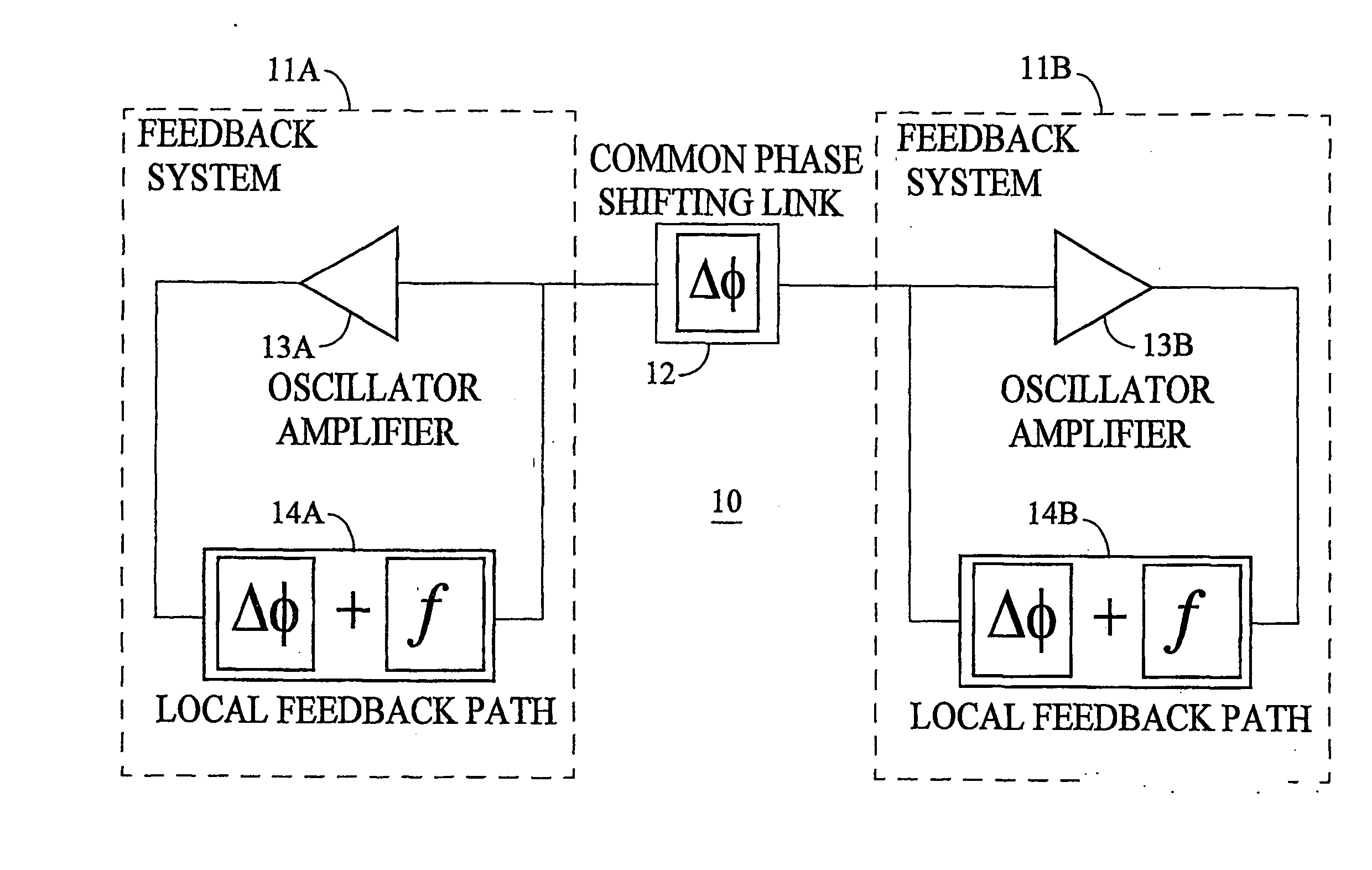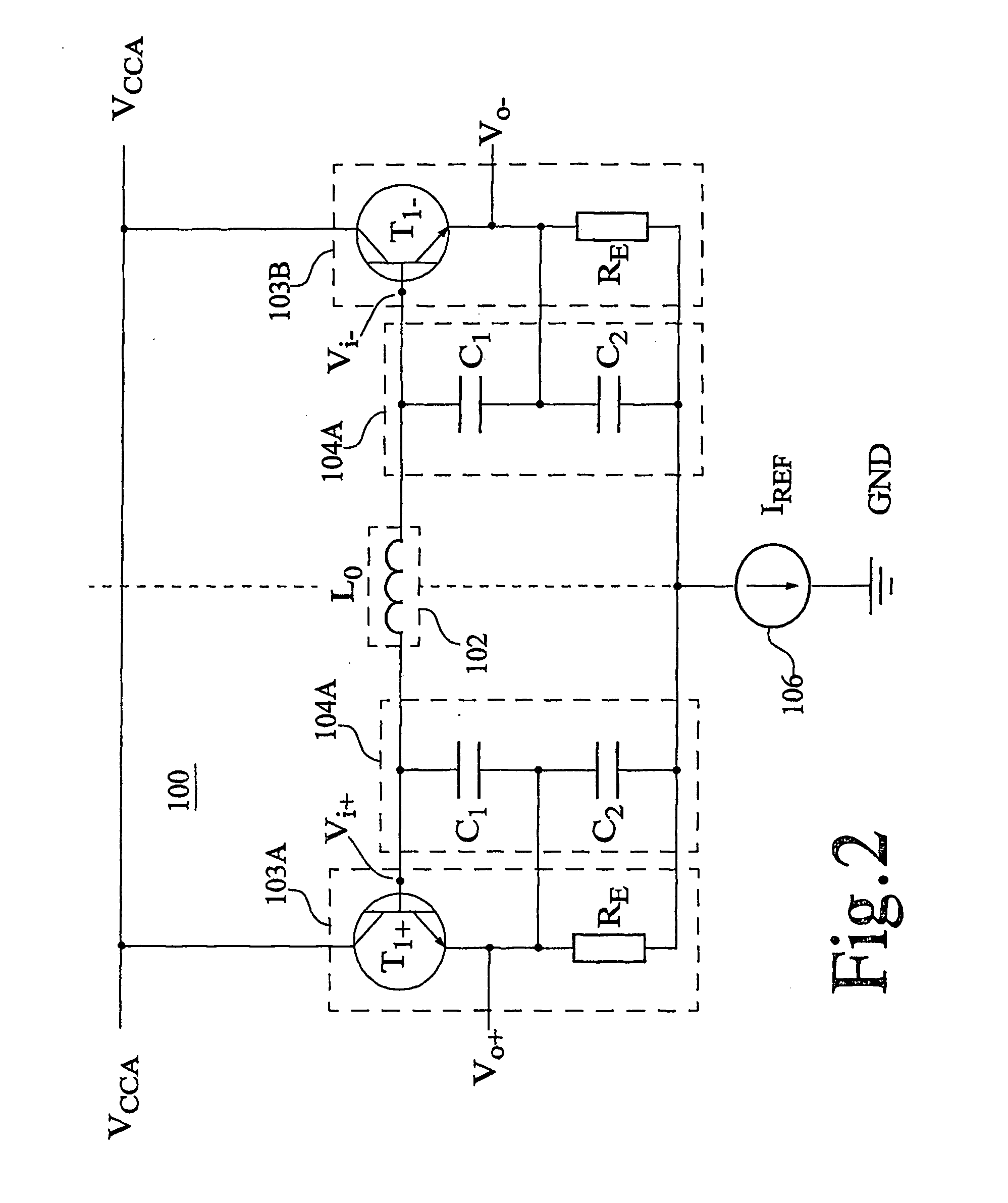Differential oscillator
a differential oscillator and oscillator technology, applied in the direction of oscillator generators, pulse generation by logic circuits, pulse techniques, etc., can solve the problems of increasing oscillation period variations, reducing phase stability, and reducing the load of colpitt oscillators, so as to achieve high symmetry and improve phase stability.
- Summary
- Abstract
- Description
- Claims
- Application Information
AI Technical Summary
Benefits of technology
Problems solved by technology
Method used
Image
Examples
first embodiment
[0055] For a better understanding of the invention, the proposed oscillator architecture will now be described in detail with reference to the invention, as outlined in FIG. 2.
[0056] FIG. 2 is a schematic circuit diagram of a resonator-based differential oscillator, excluding tuning and bias circuitry, according to a first embodiment of the invention. The differential oscillator 100 basically comprises two branches interconnected by a common inductive element L.sub.0. Each branch includes an oscillator amplifier 103A / 103B with a capacitive local feedback path 104A / 104B. In this particular is example, each of the oscillator amplifiers 103A / 103B is preferably realized as a low-impedance buffer amplifier such as a transistor-based emitter follower. An emitter follower is basically a bipolar transistor T.sub.1+ / T.sub.1- in appropriate configuration with a resistance R.sub.E. It normally has a voltage gain that is slightly less than unity, a large current gain, large input impedance and ...
second embodiment
[0064] FIG. 4 is a schematic circuit diagram of a more elaborated differential oscillator according to the invention. In similarity to the differential oscillator of FIG. 2, each branch of the oscillator 200 includes an emitter follower buffer amplifier 203A / 203B with a capacitive local feedback path 204A / 204B. However, the differential oscillator shown in FIG. 4 also includes additional circuitry for various functions such as tuning and bias, amplifier gain limitation, crystal or SAW resonator enhancement as well as a voltage-reference-stabilized current source and first-level output buffers.
[0065] Instead of a single inductive element in the common connection link between the inputs of the emitter-follower based amplifiers 203A and 203B, the common link 202 now includes a crystal XTAL connected in series with the inductive element L.sub.0. It is also possible to use a surface acoustic wave (SAW) device for resonator enhancement instead of or in combination with the crystal. In thi...
third embodiment
[0071] FIG. 7 is a circuit diagram of a differential oscillator according to the invention. The differential oscillator 500 comprises two branches interconnected by a common capacitive link 502. In this realization, each of the local feedback paths associated with the emitter-follower based oscillator amplifiers 503A and 503B is made up of an inverting feedback amplifier 505A / 505B with an embedded capacitive phase shift filter. Preferably, the phase shift function in the feedback loop is generally based on an ideal inverting feedback amplifier together with the phase shift filter capacitor C.sub.1. In addition, by introducing an emitter-decoupling capacitor C.sub.E1 for each emitter-follower based oscillator amplifier 503A / 503B, the oscillator amplifier will also act as an integrator in the local feedback path. In practice, the emitter-decoupling capacitor C.sub.E1 forms an additional capacitive phase shifting element in the local feedback path. The resistance R.sub.C2 has a biasing...
PUM
 Login to View More
Login to View More Abstract
Description
Claims
Application Information
 Login to View More
Login to View More - R&D
- Intellectual Property
- Life Sciences
- Materials
- Tech Scout
- Unparalleled Data Quality
- Higher Quality Content
- 60% Fewer Hallucinations
Browse by: Latest US Patents, China's latest patents, Technical Efficacy Thesaurus, Application Domain, Technology Topic, Popular Technical Reports.
© 2025 PatSnap. All rights reserved.Legal|Privacy policy|Modern Slavery Act Transparency Statement|Sitemap|About US| Contact US: help@patsnap.com



